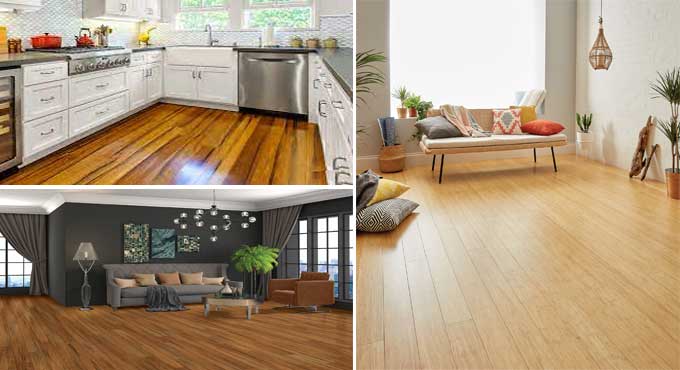
Is Bamboo flooring a nice choice for your home?

Global demand for bamboo as a construction material is rising quickly. It is well-liked for its adaptability, flexibility, affordability, and accessibility. Bamboo has an extremely strong fiber, making it a sustainable and long-lasting building material. Shear stress in bamboo fiber is greater than in wood.
Compared to wood, bamboo has a broader spread. Moreover, bamboo is a sustainable material that can be grown with very little energy, prevents soil erosion, produces biofuel, and increases animal habitat.
In terms of aesthetics and environmental friendliness, it has also created a name for itself in the flooring sector. Bamboo has an exotic look and is available in a variety of hues and finishes.
Bamboo Flooring
A type of flooring material manufactured from the bamboo plant is called bamboo flooring. Since that bamboo is a quickly regenerating resource that can be harvested without causing the plant to die, it is an environmentally benign and long-lasting alternative for flooring.
Solid bamboo or engineered bamboo can be used to make bamboo flooring. Cutting bamboo stalks into thin strips, which are then bonded together to form planks, is how solid bamboo flooring is created.
A thin veneer of bamboo is layered over a substrate composed of wood or another material to create engineered bamboo flooring.
The beauty and durability of bamboo flooring are well known, and it can be found in a variety of colors and finishes, from light to dark, and on matte or glossy surfaces. Homeowners and designers choose bamboo flooring because of its easy installation and maintenance.
Benefits of Bamboo Flooring
1. It is well-liked by individuals who favor modern design because of its sleek and sophisticated appearance.
2. Bamboo seems more natural and opulent when compared to other flooring substitutes that mimic wood.
3. Bamboo flooring that has been properly polished is simple to maintain with only a mop and some light soap.
Drawbacks of Bamboo Flooring
1. As low-quality bamboo flooring is vulnerable to dents and scratches, high-quality bamboo flooring should be utilized.
2. Because of its propensity to absorb water, it is inappropriate for use in bathrooms, laundry rooms, and even basements.
3. Bamboo flooring, in contrast to other types of flooring, offers a small selection of tonal tint possibilities.
Bamboo flooring types
Horizontal-type Bamboo flooring
The horizontal strips of bamboo used to create the plank for horizontal bamboo flooring provide a larger and more pronounced grain.
It has a nicer aesthetic than strand-woven bamboo but is not as tough and long-lasting. It has varied color stains that offer diverse tints and tones, or it has a finish that gives it a more conventional, worn appearance.
Vertical type Bamboo flooring
Afterward, cut thin strips of bamboo are bonded together vertically for this sort of bamboo flooring.
Its fine grain pattern makes it possible to view traces of the bamboo's knot structure. It most closely matches the natural look of bamboo among all varieties of bamboo flooring.
Strand Woven type Bamboo flooring
The bamboo strands used to create this type of flooring are compressed using high heat and pressure. Also, it explains why strand-woven bamboo flooring is the most resilient and robust type of bamboo flooring. It appears to have a haphazard grain pattern.
It is also the most expensive type of bamboo flooring and is highly resistant to scratches and dents. As such, it is often the best choice for homes with kids or pets.
Various color options in Bamboo flooring
Natural Bamboo Color for bamboo flooring
As the name implies, there have been no treatments or color stains added; it is simply the bamboo's natural hue. It is among the most widely used hues for bamboo flooring because of the bright, golden hue that runs throughout.
Bamboo flooring in its natural color is a great way to bring a touch of natural beauty to any home. It adds warmth and a classic look without sacrificing any of the durability that bamboo is known for. Additionally, the vibrant hue is an excellent way to brighten a room.
Stone Grey Color for bamboo flooring
As modern and minimalist designs have proliferated, the popularity of flooring in shades of grey has grown. Bamboo flooring?s distressed surface appeals to individuals who like a floor with a more distinctive appearance.
Grey flooring is a great option for those who want to make a statement in their home, but don't want to go too bold. It's also versatile, as it pairs well with many different colors and styles. Finally, grey flooring can create a sense of sophistication and elegance in any room.
To learn more, watch the following video tutorial.
Video Source: Cali Floors
Maintenance of Bamboo Flooring
1. A dust mop is usually preferable while mopping. Compared to any other type of mop, it helps remove dirt and grime considerably better.
2. Be sure to select a stiff-bristled brush that can effortlessly remove dirt from even the trickiest areas.
3. Avoid using the wet mop at all costs, and if it's essential, wring the mop out completely to prevent excess water from spilling onto the floor.
4. Avoid wearing high heels and barefoot on bamboo flooring since it can be damaged by sharp items.
5. While purchasing cleaning detergents, be careful to keep your flooring's safety in mind. The majority of detergents include specific compounds that might fade the flooring's color.


